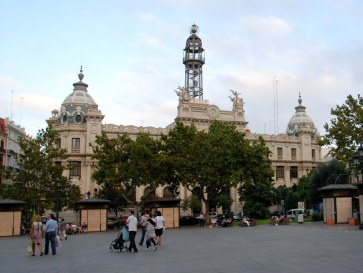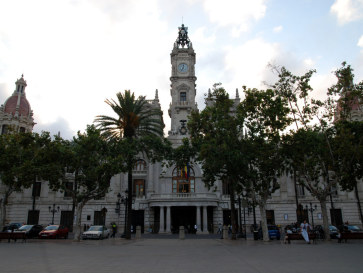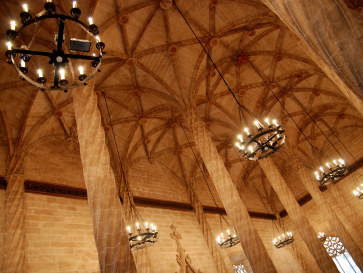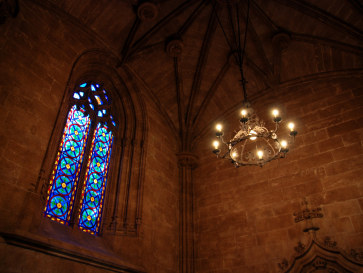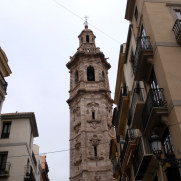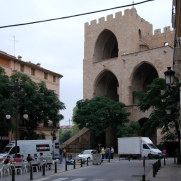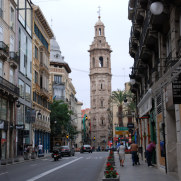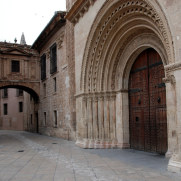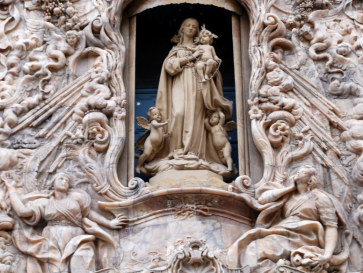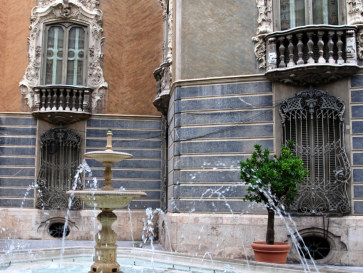Готический собор Святой Марии (Catedral de Santa María de Valencia) – это главный храм Валенсии (Valencia). Важнейшим сокровищем собора является полупрозрачная чаша, называемая Святым Граалем, преподнесенная в дар собору королем Арагона Альфонсо V Великодушным в 1437 году. До 1916 года чаша хранилась в зале с реликвиями, но затем была перенесена в капитульный зал с капеллой Санто-Калис (Santo Cáliz), где хранится до сих пор.
Немного об истории собора, прежде, чем перейдем к «сладкому».))
Кафедральный собор Валенсии находится в самом центре Старого города Валенсии, по адресу Plaza de la Reina (Plaça de la Reina).
Северный фасад собора выходит на площадь Plaza de la Virgen (другие названия площади: Plaça de la Marede Déu или Plaça de la Seu).
Кафедральный собор в Валенсии был построен в 1238 году на месте бывшего римского храма Дианы – богини плодородия, флоры и фауны. Его еще называют La Seu (Ла Сео), то есть «архиепископская епархия».
На 68-метровую башню ведет винтовая лестница со смотровой площадкой.
Западный фасад собора с Апостольскими вратами (Puerta de los Apóstoles) выходит на площадь Святой Девы. Такое название ворота получили из-за скульптур двенадцати апостолов, расположенных у входа. Фасад создавался в период 1303-54 гг. Автором арочной конструкции был архитектор Николас де-Аутона.
На площади plaza de la Reina можно увидеть металлический макет Валенсийского собора.
Здесь же врата «Лос Йеррос» (Puerta de los Hierros) – “Железные ворота” (1703-13 гг.) – главный вход в церковь. Эти врата были созданы архитектором Конрадом Рудольфом в стиле итальянского барокко.
Внутренний интерьер собора…
Капелла Санто-Калис (Santo Cáliz), где хранится Святой Грааль…
А вот и та самая заветная чаша…
«Но вот очутилась в зале Священная чаша Грааль под белым парчовым покровом, однако никому не дано было видеть её и ту, что её внесла…» (Томас Мэлори)
Начитавшись романов Дэна Брауна и его коллег, тема таинственного сосуда с кровью Иисуса занимает и мой бестолковый ум.))
Надо сказать, что впервые тема Грааля появляется в 1190 г. в литературном произведении французского поэта Кретьена де Труа «История Грааля», повествующем о юном Персивале, приближенном короля Артура, который попадает в замок загадочного короля-рыбака. Во время трапезы в зал входит красивый юноша с копьем, с которого капает кровь, а за ним — прекрасная молодая женщина с Граалем в руках. Чаша была из чистого золота и украшена множеством драгоценных камней; от нее исходило удивительное сияние. Во время обеда ее пустили по кругу. В рассказе говорится, что, поскольку заинтригованный Персиваль ничего не спросил ни о Граале, ни об окровавленном копье, зловещее предсказание осталось в силе: король-рыбак не сможет излечиться от ран на бедре, сделавших его калекой; его страна будет уничтожена, погибнут сотни рыцарей, и многие вдовы и сироты наденут траур.
Известной же во всей средневековой Европе легенду о Святом Граале сделал Робер де Борон (французский поэт 12-13 века). Он одухотворил обычную чашу, упоминавшуюся во французском романе, и превратил её в кубок Тайной вечери, тот самый кубок, в который, по преданию, собирал кровь Христа после распятия Иосиф Аримафейский. Де Борон также был первым, кто упомянул о перевозе Грааля в Британию, где он был спрятан. С тех пор на острове существовала династия хранителей Грааля, одним из которых впоследствии стал Персеваль.
В книге «Код Да Винчи» Дэна Брауна идет разговор о фреске Леонардо да Винчи «Тайная вечеря». Согласно библейскому сюжету, именно на Тайной вечере, накануне предательства Иуды и ареста Иисуса, Спаситель пил из чаши вино. Но на фреске Леонардо чаша на столе отсутствует, зато справа от Иисуса сидит один из апостолов, имеющий скорее женские черты, нежели мужские. В романе автор предполагает, что это – не Иоанн, как считалось ранее, а… Мария Магдалина. Дэн Браун предполагает, что Иисус и Мария Магдалина были женаты, более того, у них родилась дочь Сара, которая впоследствии положила начало династии Меровингов. После этого понятие «Святой Грааль» стали употреблять в значении «святая кровь» и заговорили о потомках Бога, которые, возможно, не без помощи ордена тамплиеров, и по сей день живут на земле.
О чаше в соборе Валенсии.
Если верить библейскому преданию, Грааль — это чаша, которой пользовался Христос на Тайной Вечере. Позже Иосиф Аримафейский, дядя Христа, сумел заполучить эту чашу у Понтия Пилата, в которую собрал кровь из ран распятого на кресте Христа, и переправил её в Британию, где Грааль стал талисманом первых христиан. Захороненная или потерянная где-то близ Гластонбери — первого центра христианства в Британии, — чаша стала объектом поисков, которые продолжались много веков. Рыцарям короля Артура каким-то образом удалось разыскать Грааль — к тому времени чаша считалась не только христианской святыней, но и неким волшебным сосудом, содержимое которого дарит обладателю вечную молодость и неземную мудрость.

Этой чаше более 2000 лет. Католическая церковь признала её подлинной святыней. Ватикан признал её «свидетельницей шагов Христа по земле».
Чаша представляет собой халцедоновый (или агатовый) кубок темно-красного оттенка высотой 7 см и 9,5 см в диаметре, стоящий на подставке с двумя ручками, которые, однако, появилась позже. Данная разновидность минерала, из которого изготовлена чаша, называется карнеолом или сердоликом и датируется I в. н.э. (по другим данным, она была изготовлена в 100-50 году до н.э.). Археолог Антонио Бельтран отнёс чашу к началу новой эры (1 век) и определил, что она была создана в мастерской Египта, Сирии или самой Палестины, что доказывает возможность нахождения чаши на Тайной Вечере.
Чаша отделана золотом, ценным жемчугом и изумрудами. Основание и две ручки чаши были добавлены в Средневековье, так что лишь сама чаша может считаться настоящей реликвией.
Одна история рассказывается следующее…
В 258 году в Риме правил император Валериан, который устраивал жестокие гонения на христиан. И как-то в его руки попался архидиакон Лаврентий, который якобы хранил у себя несметные сокровища Римской христианской церкви. На все приказы императора отдать сокровища, чтобы пополнить истощенную казну (к тому же необходимо было уничтожить особенно почитаемые у христиан реликвии и тем самым навсегда избавить страну от ненавистной Валериану религии), Лаврентий отвечал отказом, за что в скором времени и принял мученическую смерть. Но несгибаемый служитель церкви перед собственной гибелью успел переправить сокровища, среди которых упоминалась и чаша Христа, в свой родной город Оска, в Испанию, к своим родителям. От них реликвия перекочевала в церковь Святого Иоанна в Пиренеях, а затем попала в кафедральный собор в Валенсии.
Другая история такова.
После смерти Девы Марии ученики Христа распределили между собой ее имущество, и чаша, из которой Христос вкушал на Тайной вечере, была увезена святым Петром в Рим. Из-за преследований, которым подвергались христиане, папа Сикст II в III веке поручил ценную реликвию св. Лаврентию, который хранил ее в своем родном городе Уэска. Там чаша находилась вплоть до 712 года, после чего спасавшиеся от мусульман христиане спрятали ее в Пиренеях, а затем в монастыре Сан-Хуан-де-ла-Пенья близ города Хака. В 1399 году монахи подарили Грааль королю Арагона Мартину I, и чаша попала в Сарагосу, во дворец Альхаферия. В 1424 году Альфонсо V Великодушный перевез реликвию в Валенсию в знак благодарности за помощь, оказанную королевством Валенсия в его средиземноморских битвах.
Кое-какие детали историй, конечно, сходятся.
Но самое интересное заключается в том, что чаш Грааля объявляли в нескольких разных местах по всему миру. Так что до сих пор нет определенности, какая из них настоящая.
В 2014 году вышла книга Маргариты Торрес и Хосе Ортеги-дель-Рио «Короли Грааля», где авторы прослеживают историю потира доньи Урраки до древнего Иерусалима и доказывают, что он вполне может быть чашей Тайной вечери. Исследование стало очередной сенсацией. Так называемый потир доньи Урраки, ониксовая чаша для богослужений в золотой оправе, украшенной драгоценными камнями, — гордость базилики Сан-Исидоро. Жившая в XI веке донья Уррака, старшая дочь Фердинанда I, короля Кастилии и Леона, была благочестивой особой и щедро одаривала церкви. Этот сосуд она преподнесла базилике Сан-Исидоро, в которой впоследствии принцессу и похоронили.

Многие путеводители по Турину утверждают, что чаша Грааля находится именно в этом городе. Перед храмом Великой Богоматери расположены 2 статуи — Веры и Религии. Статуя Веры держит в левой руке чашу, в которой местные жители видят изображение чаши Грааля. В путеводителях сказано, что взгляд статуи указывает то направление, в котором следует её искать.
Еще один город – «убежище» Грааля – итальянская Генуя. Чаша, хранящаяся там в соборе Святого Лоренцо, сделана из стекла изумрудного цвета и имеет необычную шестигранную форму. Происхождение этого раритета неизвестно, в документах указано только то, что его забрали в качестве трофея из мечети в Кейсарии в Палестине во время первого крестового похода.
По свидетельству Гийома Тирского, это трофей крестоносцев, найденный в одной мечети в древнем палестинском городе Кесарее в 1101 г. Отождествление с Граалем основано на «Золотой легенде» Якопо Ворагинского — собрании христианских преданий XIII века, где сказано, что Иисус с учениками на Тайной вечере пил из изумрудной чаши. Когда Наполеон захватил Геную, он перевез святыню в Париж. Затем чашу вернули обратно, однако в пути она треснула. Так с трещиной ее сейчас и лицезрят.
Другие следы чаши ведут в базилику Сан-Лоренцо-фуори-ле-Мура в Риме.
Многие фрески в этом храме, на которых есть изображение Грааля, указывают на то, что чаша спрятана в катакомбах, расположенных под базиликой. Кстати, сам храм построен на месте погребения святого Лаврентия, что тоже наводит на мысль о закономерности хранения там реликвии. В 1938 году монахом-капуцином Джузеппе Да Бра была произведена подробная опись помещений катакомб. В ней упоминается 20-метровая комната со стоящими в ней скелетами. Один из скелетов держит в руках сосуд, по всем признакам похожий на Святой Грааль.
Чаша из Метрополитен-музея в Нью-Йорке представляет собой два серебряных сосуда, вставленных один в другой. Наружный, позолоченный, украшен замечательными рисунками, изображающими Сына Божьего и некоторых его соратников-апостолов.
Чаша была отреставрирована во Франции и в 1933 году выставлена на Всемирной выставке в Чикаго как чаша Тайной Вечери.
Ученые, проведя анализы и исследования, пришли к выводу, что внешняя чаша сделана несколько позднее, чем внутренняя, которая выглядит гораздо скромнее, но вызывает больше споров. Ученые установили, что время ее изготовления – I век н. э., и она вполне может оказаться знаменитым Граалем. Чаша была найдена при раскопках в городе Антакья (Антиохия) на юге Турции.
«…у него тоже было тайное желание, которое он хотел загадать Святому Граалю…»
Говорят, что все, что загадаешь около Грааля, все сбывается. Ну, дай бог!
Священный Грааль в Кафедральном соборе Валенсии
Валенсийский Священный Грааль – это уникальная христианская реликвия, чья подлинность официально признана Ватиканом.
Справа от главного входа в Кафедральный собор Валенсии (la Catedral de Valencia), в небольшой часовне под названием «Santo Caliz» (исп. «Святая чаша») находится главная священная реликвия Валенсии — Чаша Святого Грааля, из которой, согласно Библии, Иисус Христос пил вовремя ужина в Гефсиманском саду.
Подтверждают это и многочисленные свидетельства и исследования, которые убедили Ватикан, признавший Святой Грааль, хранящийся в Кафедральном соборе Валенсии, именно той священной чашей, которую поднял Спаситель над головами своих учеников во время Тайной вечери. Однако многие скептики опровергают данный факт, опираясь, прежде всего на то, что на ножке чаши можно разглядеть чёткую надпись на арабском языке. Дело в том, что священной реликвией признана лишь сама чаша, то есть верхняя часть сосуда, в том время как его ножка выполнена в более поздний период, когда на валенсийской земле властвовали мавры, пришедшие с африканского континента.
Несомненно, вид Святого Грааля вызывает непередаваемое восхищение, если подумать о его истории и о том, что пришлось повидать этой священной реликвии на своём веку. Согласно официальным данным и археологическим исследованиям, валенсийская Святая чаша была изготовлена между 50 и 100 годами до Рождества Христова. В частности, к этим выводам пришёл выдающийся профессор Антонио Бельтран (Antonio Beltrán Martínez) из Университета Сарагосы (Universidad de Zaragoza) в Испании. Именно его исследования, опубликованные в 60-х годах прошлого века и до сих пор не опровергнутые, окончательно убедили представителей Ватикана в подлинности валенсийского Святого Грааля.

По легенде, после распятия Христа чаша была привезена Святым Петром в Рим, где и хранилась на протяжении многих веков правления первых 23 пап. И только при Папе Сиксте II (III век нашей эры) Святой Грааль был отослан в Испанию под присмотром и охраной дьякона-испанца, известного под именем Святого Лаврентия (San Lorenzo). Сикст II был вынужден пойти на такой отчаянный шаг, опасаясь христианских гонений императора Валериана. Так священный Грааль обосновался в Испании, в соборе города Уэска (Huesca), что в провинции Арагон. С этого начался испанский период в истории Святой чаши.
После мавританского вторжения в 711 году кубок на протяжении многих веков укрывался в пещерах сначала в районе испанских Пиренейских гор, а потом и вовсе во французских Пиренеях, пока снова не вернулся в Уэску в монастырь Сан-Хуан-де-ла-Пенья (San Juan de la Peña), о чём можно найти упоминания в монастырских хрониках конца XI века. После кубок хранился в соборах и монастырях Барселоны, пока в 1436 он не был доставлен в Кафедральный собор Валенсии королём Альфонсо V Великодушным (Alfonso V el Magnánimo).
Однако на этом приключения Святого Грааля не закончились: во время войны за независимость между 1809-1813 годами, священная реликвия была вывезена на хранение в Собор города Аликанте, а оттуда отправлена на остров Ибица, а позже – на Пальму-де-Мальорку, чтобы в этот раз спасти чашу от французских захватчиков под предводительством Наполеона. И только столетие спустя, в 1916 году она снова оказалась в Кафедральном соборе Валенсии, где и хранится до сих пор.

Уникальная чаша размером всего 17 см в высоту и 9 см в ширину – это уникальное произведение искусства, украшенное золотом, жемчугом и другими драгоценными камнями, которое вызывает священный трепет у каждого, кто её видит. Особенную ценность валенсийскому Священному Граалю придаёт тот факт, что именно этот сосуд был использован для богослужения Папой Иоанном Павлом II во время его визита в Валенсию в 8 ноября 1982 года, а сменивший его Папа Бенедикт XVI, по прибытию в Валенсию, исполнил священный обряд Евхаристии 8 июля 2006 года.
Чаша Святого Грааля, находящаяся в Кафедральном соборе города, ежегодно привлекает тысячи паломников, которые приезжают в Валенсию, чтобы воочию узреть истинную христианскую реликвию.
Священный Грааль Валенсии
Священный Грааль Валенсии, признанный Ватиканом
Самый «правильный» Грааль — в Валенсии!
В Кафедральном соборе Валенсии (Catedral de Valencia), в капелле Санто Калис (в переводе — святая чаша), что справа от входа, хранится Чаша Святого Грааля — чаша, из которой пил Иисус на тайной вечере. Согласно археологическим данным и свидетельствам имеющихся документов, большая вероятность того, что именно этот красивый сосуд и был в руках Иисуса на Тайной Вечере, когда он, взяв хлеб, и, подняв глаза к небу, благодаря Господа, преломил и подал ученикам, говоря: «сие есть тело Мое, которое за вас предается; сие творите в Мое воспоминание. Также и чашу после вечери, говоря: сия чаша есть Новый Завет в Моей крови, которая за вас проливается” (Лук. 22:19,20). Первое впечатление при виде Святой Чаши — восхищение и одновременно скептицизм. Посетитель чувствует себя плененным красотой Грааля, видя его прекрасные и странные формы, детали из золота, жемчуга и драгоценных камней. Вспоминаются легенды, фильмы и книги, связанные с Граалем. Но и с долей скептицизма из-за арабской надписи на ножке сосуда.
Но это не должно ввести нас в замешательство, так как на самом деле бесценной реликвией является лишь верхняя часть, чаша из полированного агата, «александрийский кубок», который археологи датируют 50 — 100 годами до нашей эры. К этому выводу привели исследования профессора Антонио Белтрана, которые были опубликованы в 1960 году, до сих пор не оспоренные и не опровергнутые, которые лежат в основе доверия подлинности Святого Грааля.
Уже позже добавилась золотая подставка с мелкой гравировкой, исламского искусства, отличающаяся стилем от чаши — все это, как и драгоценности, украшающие ножку, времён средневековья. Размеры скромны: чаша имеет высоту 17 см., ширину 9 см. и эллиптическая база 14,5 х 9,7 см.
Традиция говорит нам, что это та самая чаша, используемая Иисусом на Тайной Вечере, которая затем была привезена в Рим Святым Петром и хранилась там первыми двадцатью тремя Папами до Сан Сикста II, который отправил её со своим дьяконом Святым Лаврентием, уроженцем Испании, в арагонский город Уэска (Испания) в третьем веке, опасаясь преследований императора Валериана, который стремился истребить христианство.
Отсюда начинается испанская история Святого Грааля.
Во время мусульманского вторжения, начиная с 714 года, кубок перепрятывался в пещерах в районе Пиренеев, в Йебре де Баса, Сиресе, Санта-Мария-де-Сасабе (ныне Сан-Адриан), Баилио и, наконец, в монастыре Сан-Хуан-де-ла-Пенья (Уэска), где можно обратиться к документу от 1071, который упоминает прекрасную каменную чашу. Реликвия была передана в 1399 году королю Арагона, Мартину Эль Умано, хранившем её в Сарагосе, а затем, переехав в Барселону, хранил её там вплоть до своей смерти в 1410, отметив Святой Грааль в описи имущества Арагонской Короны. Его преемник, король Альфонсо V Великодушный, по причине своего пребывания в Неаполе, доставил чашу с другими мощами в собор Валенсии в 1436 году.Там она хранилась на протяжении веков среди других реликвий собора. Во время войны за независимость между 1809 и 1813, была отправлена на сохранение в Аликанте, а затем в Ибицу и Пальму де Майорка, чтобы спасти её от наполеоновских захватчиков, а в 1916 году — опять в Валенсию.Во время Гражданской войны (1936-1939) был спрятан в валенсийской деревне Карлет, а после окончания войны 30 марта 1939 года Святой Грааль был окончательно установлен в капелле валенсийского Кафедрального Собора, где его можно видеть и по сей день. Папа Иоанн Павел II отслужил мессу со Святым Граалем в ходе визита в Валенсии 8 ноября 1982 года, Папа Бенедикт XVI также выполнил обряд Евхаристии с чашей по случаю V Международной встречи семей 8 июля 2006 года.
Собор Успения Богоматери стоит на месте древнего римского храма, превращенного затем в вестготскую церковь.
Был этот собор и мечетью. Существующий собор начал строиться в XIII веке. Его называют энциклопедией архитектурных стилей. Храм неоднократно достраивали и в нем можно найти образцы самых разных художественных направлений: от романского искусства и готики до ренессанса, барокко и неоклассицизма… но самое главное в нем хранится Святой Грааль.

Туристов запускают в Собор через главный вход «Железных Врат» (Puerta de los Hierros), расположенный со стороны соседней Площади Королевы (Plaza de la Reina).
1.
Колокольня собора Микалет (в честь святого Михаила) видна издалека. Если быть честным, то она названа в честь колокола который отбивает каждый час и называется колоколом святого Михаила)))). На башню можно подняться (за дополнительную плату 2 евро) и посмотреть на Валенсию сверху. Винтовая лестница насчитывает 207 ступенек.
2.
Строительство колокольни было начато в 1381 году, в честь чего в основании башни была вырезана соответствующая надпись, которая уже нечитаема.
3.
Верхний ярус портала украшен горельефом на тему Успения Богоматери. В нижней части установлены скульптуры двух святых, а выше символ Святого Духа. Венчает портал разорванный фронтон с крестом на бронзовой сфере, окруженным двумя каменными изваяниями ангелов.
4.
Это стиль барокко.
5.
Занятная лошадка )))) еле стоит.
6.
7.
8.
Лёва мечтательно смотрт вверх.
9.
Обезьянки какие у него в ногах.
10.
Вход в музей платьный — 5,50 евро. Но зайти надо, в капелле собора хранится агатовая чаша Santo Cáliz, именуемая Святым Граалем. Согласно легенде, это та самая чаша, из которой Христос вкушал на Тайной вечере. Чаша официально признана Католической церковью.
11.
Огромный зал. Но потолки видел и повыше… внутри создается впечатление легкого хаоса. Симметрии мало.
12.
Из века в век храм достараисвался и увеличивался в своих размерах (удлиннялся сначала 1-3 части, затем пристроили 4 и 5.)
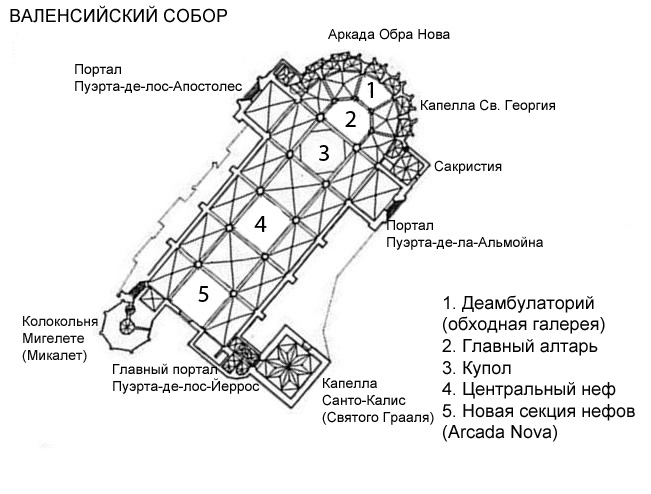
13.
14. 15.
15.
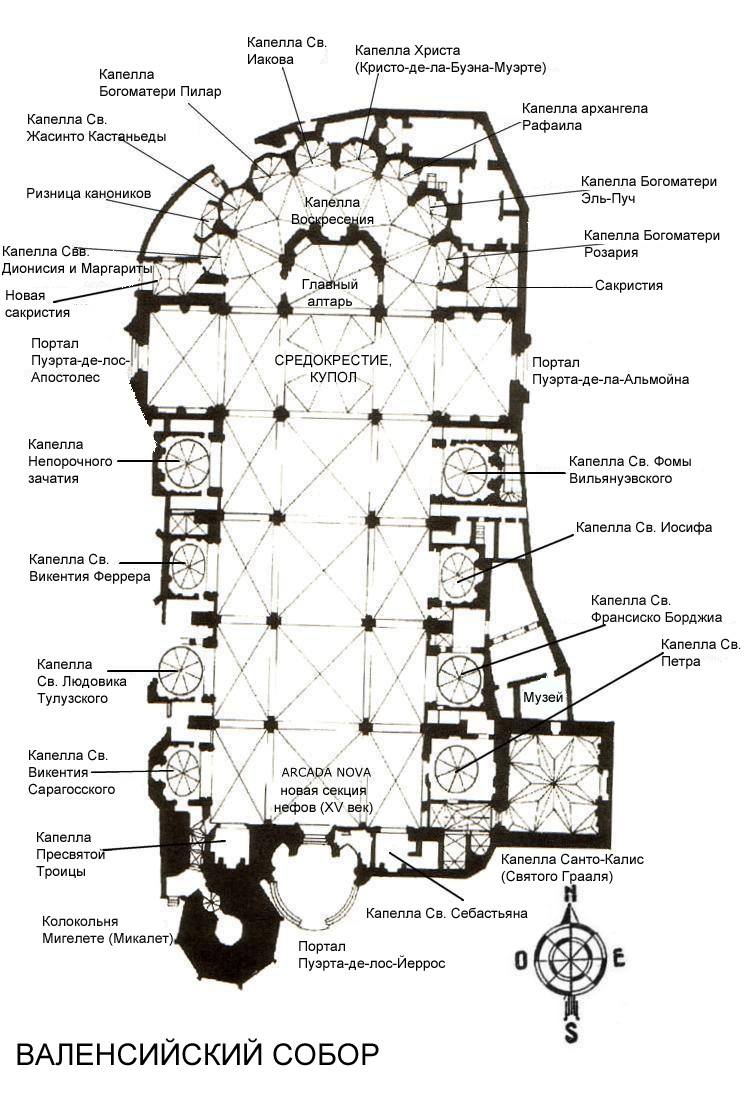
В переходе можно увидеть пять каменных готических надгробий, в том числе надгробие епископа, повелевшего выстроить зал капитула.
16.
В музее собора можно увидеть множество интересных произведений искусства, в том числе поразительные ренессансные фрески в алтарной части (открытые совсем недавно, в 2004 году) и картины художников раннего Возрождения.
17.
В храме большой музей… и иконы и картины и скульптуры, в том числе и подленники что раньше стояли на карнизе храма.
18.
19.
20.
21. 22.
22.
23.
24.
25.
Разных чаш здесь много.
26.
Попробуй разберись где Грааль… )))
27.
28.
Вот его копия. А оригинал на 1 этаже среди золотых витрин… и подойти к нему так близко уже нельзя. Вопрос подлинности для католиков закрыт. Они признали эту чашу официально.
29.
Основание и две ручки чаши были добавлены в Средневековье, так что лишь сама чаша полированного агата может считаться настоящей реликвией.
30.
Сейчас на крыше храма стоят копии. А это подлинники. Статуи в реальный человеческий рост того времени.
31.
Всего фигурок насчитывается 48, и они когда-то были полихромными.
32.
Легкий садизм какой-то.
33.
У этой картины словно хваст у Иисуса, прости господи этого художника.
34.
35.
36. 42.
42.
Пора посмотреть настоящую чашу…
37.
Небольшой квадратный зал с красивым сводчатым потолком.
38.
Подсветка впечатляет. Здесь и стоит Грааль.
39.
Раньше чашу использовали в религиозных церемониях, но в 1744 году чьи-то кривые руки ее случайно уронили на пол, и она раскололась, после чего решено было ее отреставрировать и в дальнейшем хранить просто как культовый предмет (теперь чаша используется только в особо торжественных случаях).
40.
Чаша изготовлена из агата или халцедона темно-красного оттенка (данная разновидность минерала называется карнеолом или сердоликом) и датируется 100 — 50 году до н.э.
41.
42.
Шкаф впечатляет…
43.
Чья-то святая рука…
44.
45. 47.
47.
46.
Большой храм.
47.
#хэшмоб #архитектураповторникам #путешествия #Валенсия #Испания
Схемы храма и часть инфы (С) https://www.mishanita.ru/
На фото: Фонтан рек. Валенсия, Испания, 2010
В нашем распоряжении оставался один полный день и распланировать оставшееся время мы традиционно решили за завтраком. Вариантов было немного: вернуться в наш штатный отель в Кап Салу или переночевать где-нибудь ещё, — не сговариваясь, мы решили, что этим самым «ещё» станет Валенсия.
Положа руку на сердце, вариант был слегка авантюрным, так как между Валенсией и аэропортом Барселоны было триста пятьдесят километров пути, но, учитывая, что наш самолёт вылетал днём, мы надеялись преодолеть их с утра. И, конечно, провести вечер в третьем по величине городе Испании было куда интересней, чем пить пиво на балконе с видом на дорогу.
Планы планами, но от Альмерии, где мы в тот момент времени находились, до Валенсии тоже ещё нужно было добраться, причём так, чтобы не растерять силы после четырёхсот километров пути по жаре и пустынной местности. Поэтому, решив особо не заморачиваться, мы разделили расстояние между этими городами пополам и, обнаружив в этом месте на карте Мурсию, сделали её нашим перевалочным пунктом.
Валенсия
О нашем пребывании в Мурсии я подробно написал в третьей главе этого рассказа, поэтому сразу перейдём к делу. В Валенсию мы въехали около четырёх часов дня и, приткнув машину где-то на бывшей набережной реки Турии, начали обзвон потенциальных гостиниц. Первая попытка завершилась неудачей: в окрестных гостиницах не было свободных номеров, — и нам пришлось переместиться в другой район, где совершенно случайно мы остановились перед отелем Mediterraneo.
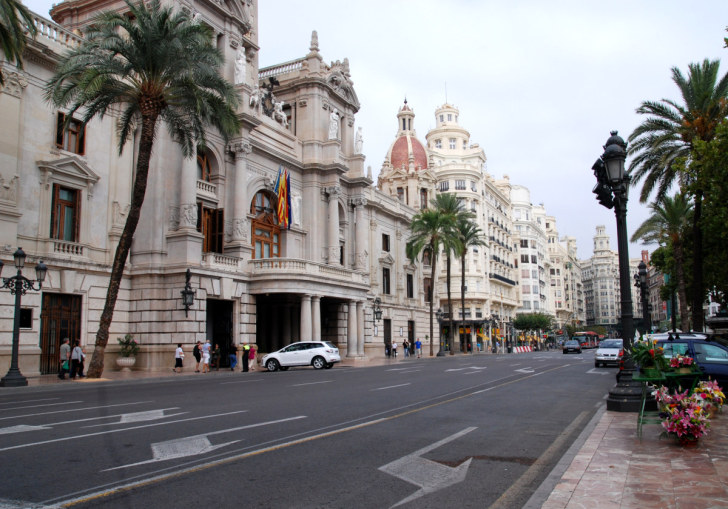
Несмотря на то, что цену за номер в сто тридцать евро нельзя было назвать «некусачей», расположение гостиницы в самом центре города, пятидесятипроцентная скидка на парковку и накопившаяся за день неделю поездки усталость помогли сделать правильный выбор — мы выгрузили вещи, отогнали машину на стоянку и к пяти вечера были готовы к покорению Валенсии.
Если верить нашему путеводителю, достопримечательностей в городе было не так уж и много. Несомненно, номером один был Кафедральный собор и его главное сокровище — святой Грааль. По легенде в чашу из зелёного агата, украшенную жемчугом и драгоценными камнями, Иосифом Аримафейским была собрана кровь распятого Христа. Крестоносцы доставили её из Иерусалима в монастырь Сан Хуан де ла Пенья (San Juan de la Pena) в Арагоне, а в 1438 году Грааль был перевезён в Валенсию.
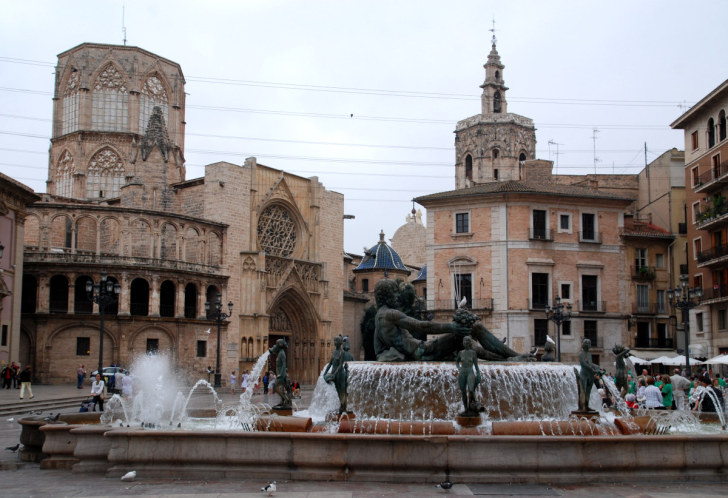
Мы же начали знакомство с городом с Plaza del Ayuntamiento, где кроме, собственно, здания Городского совета располагался также Главный почтамт и целая вереница зданий XVIII-XIX веков постройки. Сделав круг по площади, мы устремились на север — к Центральному рынку, но, несмотря на то, что, построенный в начале XX века, он считался одним из самых больших крытых рынков Европы, привлекло нас здание напротив, меньшее по размерам, но более изящное — Шёлковая биржа (Lonja de la Seda).
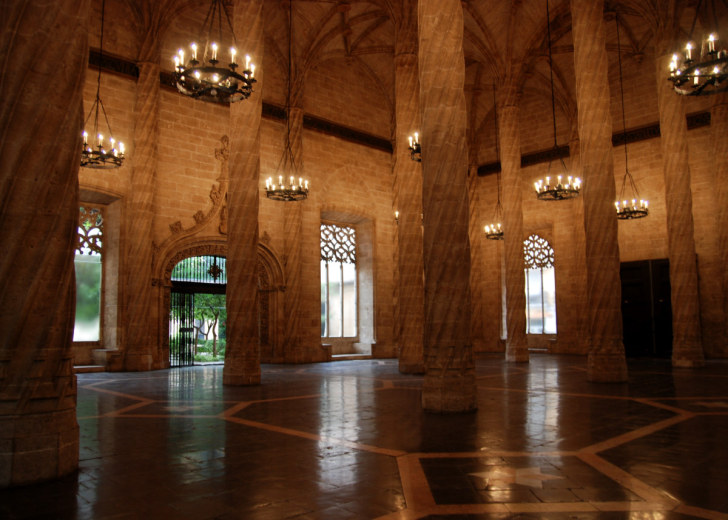
Построенная в конце XV века биржа долгое время являлась главным торговым центром Валенсии, потихоньку «обрастая» профильными ведомствами. В XVI веке к ней был пристроен новый корпус, который заняло Морское консульство, занимавшееся регулированием морской торговли.
Признаться честно, биржа стала номером один в нашем рейтинге достопримечательностей Валенсии и, наверное, не зря она была включена в Список Всемирного наследия ЮНЕСКО как один из лучших образцов гражданской готической архитектуры в Европе. Впрочем не так далеко от неё располагался и «номер два» в рейтинге, правда добрались мы до него не сразу.
Следом за биржей начинался исторический квартал Валенсии, представлявший из себя со слов путеводителя «хитрое переплетение узких улочек с миниатюрными площадями и старыми домами», но то ли мы слишком быстро шли, то ли не туда смотрели — не прошло и десяти минут, как мы пересекли эту часть города и оказались у Башен Серрано (Torres de Serranos). Хотя последние и входили в топ мест Валенсии, задерживаться рядом мы не стали, так как раза три проезжали мимо, пока искали гостиницу двумя часами раньше.
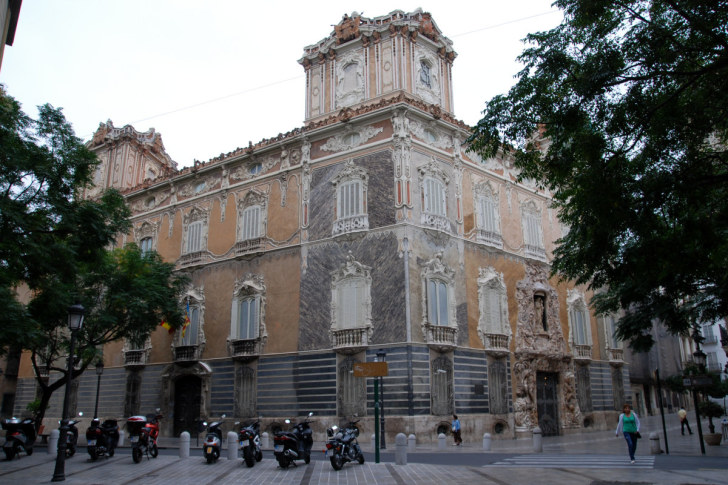
Нырнув обратно в «хитросплетение» улиц, мы снова очутились у Кафедрального собора и, пройдя пару кварталов на юг, наконец вышли к «номеру два». Говорят, интерьеры дворца маркиза Дос Агуас (Palacio del Marqués de Dos Agüas) стоят того, чтобы их увидеть, нам же вполне хватило экстерьера, чтобы поставить его на столь высокое место в своём рейтинге.
Обойдя с трёх сторон здание дворца, которое с середины XX века являлось по-совместительству и Национальным музеем керамики и декоративно-прикладного искусства имени своего основателя Гонсалеса Марти, мы поняли, что насытились пищей духовной и зашагали обратно в сторону Plaza del Ayuntamiento, чтобы где-нибудь не слишком далеко от отеля найти пищу плотскую место для ужина.
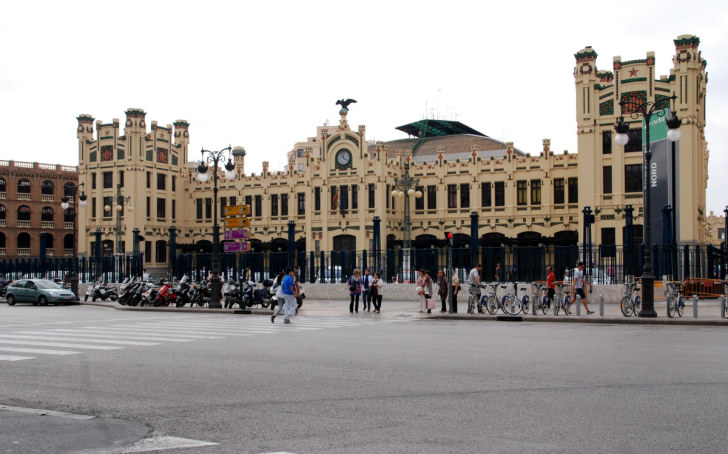
Учитывая то, что главным кулинарным специалитетом Валенсии являлась паэлья, не сложно было догадаться какие заведения попадались нам на пути. Поэтому, чтобы найти наконец просто ресторан с белыми скатертями и красивыми бокалами, нам пришлось намотать ещё один круг по окрестностям теперь уже нашего отеля и пройти ещё пару «знаковых» мест, начиная со здания Северного железнодорожного вокзала (Estació del Nord) и заканчивая Ареной для корриды (Plaça de Bous), — но зато найденный в итоге ресторан Navarro стал лучшим за всю поездку.
Как увидеть Святой Грааль в Валенсии
Одвайзер
пошаговые инструкциипо приключениям
Как покататься на борде по вулканам в Никарагуа?Как погулять по действующему вулкану в Греции?Как покормить летучих собак в джунглях Таиланда?Как покататься на велосипеде по Китайской стене?Как искупаться в знаменитом Фонтане Треви в Риме?Как покататься на каяках по каналам Венеции?Как погулять по крышам небоскребов в Дубае?
Присоединяйсячтобы приключаться!Посмотри на культовую библейскую чашу Иисуса в Валенсийском соборе. По легенде, она принесёт благодать и достаток каждому, кто её увидит.
Чаша Святой Грааль (Graal) преодолела немалый путь за 700 лет, прежде чем воссиять на алтаре Кафедрального собора Валенсии.По легенде, полупрозрачную чашу, украшенную изумрудами и золотом, из которой Иисус вкушал на Тайной вечере, увезли в Рим. И только в 1424-м году Святой Грааль был передан в дар Валенсии. Раньше чаша была атрибутом религиозных процессий. Но однажды её уронили, и после реставрации было решено поместить её под стекло как культурную реликвию храма.
Как это сделать?
1. Зайди в собор через главный вход, именуемый как Железные врата.
2. Здесь, на алтаре Капеллы Святого Грааля, ты найдёшь ту самую чашу. Каждый, кто её увидит, будет прощён в своих грехах, а стол его никогда не будет пуст.
Где это сделать?
№1Кафедральный собор ВаленсииГлавный собор Валенсии представляет разнообразие архитектурных стилей от романского до неоклассицизма. Здесь хранятся Чаша Грааля и полотна Гойи.
10Где находится: Площадь де АльмоинаЧасы работы: Пн-Сб: 10:00 — 18:30, Вск: 14:00 — 18:30
Телефон: +34 963 918 127
Официальный сайт: http://www.catedraldevalencia.es
Когда это сделать?
С 20 марта по 31 октября: 10:00 — 18:30 с понедельника по субботу. Воскресенье и праздничные дни: 14:00 — 18:30.
С 1 ноября по 19 марта: 10:00 — 17:30 с понедельника по субботу.
Сколько стоит?
Входной билет для взрослых — €7
Для групповых посещений — €4 с человека.
Для пенсионеров, инвалидов и детей до 12 лет — €5.50.
Сохрани!в планах1
лайки6поделись в
Фейсбукеподелись в
Твитереподелись в
Гугл+поделись в
Контакте
